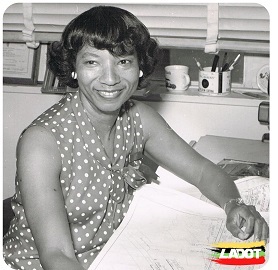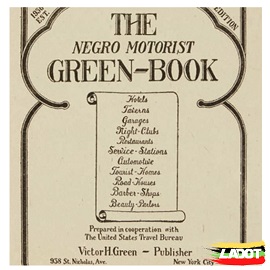
At LADOT, we recognize the extensive contributions of African Americans to the progress of the transportation sector both in our own time and throughout history. As part of L.A.’s African American Heritage Month, LADOT is highlighting some of these innovative contributions, ranging from those created by individuals to those that resulted from the collaborations of many. This week, we are spotlighting influential African Americans in transportation who embraced innovation and opportunity despite barriers such as segregation and discrimination.
Garrett Morgan
 In 1923, African American businessman and inventor Garrett Morgan patented a hand-cranked three-position semaphore traffic management device after realizing that the manually operated two position traffic signals did not allow enough time for drivers to react between the “stop” and “go” phases. Morgan’s innovation incorporated a third position interim “warning” that created a smoother traffic flow. This traffic signal was used throughout North America until all manual traffic signals were replaced by early models of the automatic red, yellow, and green light traffic signals.
In 1923, African American businessman and inventor Garrett Morgan patented a hand-cranked three-position semaphore traffic management device after realizing that the manually operated two position traffic signals did not allow enough time for drivers to react between the “stop” and “go” phases. Morgan’s innovation incorporated a third position interim “warning” that created a smoother traffic flow. This traffic signal was used throughout North America until all manual traffic signals were replaced by early models of the automatic red, yellow, and green light traffic signals.
Lois Cooper
 Lois Cooper paved the way for many African American women when she became the first female African American transportation engineer to be hired in the engineering department at the California Department of Transportation in 1953. As an engineer, she worked on several projects that Angelenos use daily to get around the city. Some of the notable projects include the I-105 Century Freeway, the San Diego Freeway, and the Long Beach Freeway. During her time with the California Department of Transportation, Cooper quickly realized that to move up the ladder she had to take and pass her license exam. After many attempts, she then became the first African American woman in California to successfully pass the Professional Engineers License Examination. Cooper's work didn't stop there—she then went on to become the first female president of the Los Angeles Council of Black Professional Engineers, where she worked with other engineers to encourage and educate black students to go into engineering and STEM fields.
Lois Cooper paved the way for many African American women when she became the first female African American transportation engineer to be hired in the engineering department at the California Department of Transportation in 1953. As an engineer, she worked on several projects that Angelenos use daily to get around the city. Some of the notable projects include the I-105 Century Freeway, the San Diego Freeway, and the Long Beach Freeway. During her time with the California Department of Transportation, Cooper quickly realized that to move up the ladder she had to take and pass her license exam. After many attempts, she then became the first African American woman in California to successfully pass the Professional Engineers License Examination. Cooper's work didn't stop there—she then went on to become the first female president of the Los Angeles Council of Black Professional Engineers, where she worked with other engineers to encourage and educate black students to go into engineering and STEM fields.
The Negro Motorist Green Book
 During a time when segregation was prevalent in the U.S., including on many public transit options, Victor H. Green's book The Negro Travelers Green Book was an annual guide book that was considered the “bible of black travel.” Compiled from 1936 to 1967, the book listed names and locations such as hotels, restaurants, and gas stations that African Americans could patronize safely. The Green Book featured locations across North America, including 224 Los Angeles locations listed in the book.
During a time when segregation was prevalent in the U.S., including on many public transit options, Victor H. Green's book The Negro Travelers Green Book was an annual guide book that was considered the “bible of black travel.” Compiled from 1936 to 1967, the book listed names and locations such as hotels, restaurants, and gas stations that African Americans could patronize safely. The Green Book featured locations across North America, including 224 Los Angeles locations listed in the book.
The Pullman Porters
 After the Civil War as railroads began to expand their reach, George Pullman founded sleeping cars allowing wealthier passengers to experience the luxuries they know at home. To help serve those passengers Pullman hired African American men, many of whom were former slaves, to help carry luggage, shine shoes, and clean sleeping quarters. Pullman porters became a coveted job and paid more than most jobs that African Americans had, but the job was still very demeaning. In 1925 a group of Pullmans created the first black union and their struggles and successes helped lay the foundation for the Civil Rights Era.
After the Civil War as railroads began to expand their reach, George Pullman founded sleeping cars allowing wealthier passengers to experience the luxuries they know at home. To help serve those passengers Pullman hired African American men, many of whom were former slaves, to help carry luggage, shine shoes, and clean sleeping quarters. Pullman porters became a coveted job and paid more than most jobs that African Americans had, but the job was still very demeaning. In 1925 a group of Pullmans created the first black union and their struggles and successes helped lay the foundation for the Civil Rights Era.

